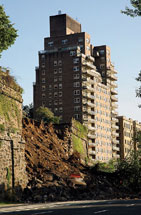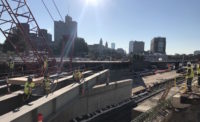 |
| Retaining wall collapse in New York City May 12 sent a massive slide across a service road and three lanes of a parkway, but caused no injuries. Clean-up crews beat the Monday a.m. commute by seven hours. (Photo courtesy of NYC Dept. of Design and Construction) |
Heavy equipment operators and contractors working through the weekend beat the clock to re-open two of three northbound lanes of a parkway buried under an urban landslide in New York City late last week. They were able to reopen the northbound lanes seven hours ahead of their 5 a.m. Monday deadline.
The slide occurred when a massive, privately-owned stone retaining wall adjacent to the Henry Hudson Parkway, just north of the George Washington Bridge, failed spectacularly on the afternoon of May 12. No injuries were reported, although a number of parked cars were buried and nearby buildings evacuated as a precaution.
A spokeswoman at the Structures Division of the New York City Dept. of Design and Construction says nearly 1,000 20-cu-yd and 40-cu-yd truck loads were hauled away. About 10 city and state agencies, as well as a number of private contractors were involved. Contributed equipment included two seismographs supplied by the Metropolitan Transportation Authority, which were used to monitor the dangerous site. "That's all we could muster up, but they worked," says the spokeswoman.
By late Monday afternoon, the job-cost tally stood at $3.8 million. That did not include the costs of the New York City police and fire departments. "We're adding it up as fast as we can so we can dump the bill on somebody," says one city official who asked not to be identified.
Witnesses say the failure of the 150-ft-long, 75-ft-high wall section occurred in two stages, resulting in landslides about 10 minutes apart. The first slide covered an access road and the parked cars with boulders and soil, and the second sent an avalanche cascading across the three northbound lanes of the parkway itself. The collapse happened during clear, dry weather.
 |
| Landslide buried parked cars and prompted evacuation of nearby buildings as a precaution. The owner of the wall had been concerned about signs of instability. (Photo by Susan Pearsall for ENR) |
Emergency crews stabilized the site by reducing the angle on slope and covering it with plastic sheeting to control erosion.
The wall is the property of Castle Village, a five-building residential co-operative on a 7-acre site overlooking the Hudson River on Manhattan's upper west side. The wall was constructed between 1907 and 1909.
Concerned by signs of instability, the owner had engaged Langan Engineering and Environmental Services, Elmwood Park, N.J., to make repairs. Langan was seeking a permit from the State Dept. of Transportation to close the access road to enable the work when the wall failed.
At a press conference May 13, Mayor Michael Bloomberg said the city's responses to concerns about the wall1s stability before the failure were appropriate. "Given they had a licensed engineer who was working on it, we didn't feel there was any reason to be doing anything else," Bloomberg said."The engineer knew there was a problem. That's why he went to the DOT for a road-closing permit."
Ilyse Fink, a spokeswoman for the city's Dept. of Buildings, says that unlike the regulations that apply to buildings taller than six stories, whose facades must pass professional inspection every five years, the city has no specific regulation requiring inspection and maintenance of private retaining walls. Most of the city's bigger retaining walls are publicly owned, she added, including about 2,000 that fall under the jurisdiction of the Dept. of Transportation. The DOT is in the process of checking them now.


Post a comment to this article
Report Abusive Comment